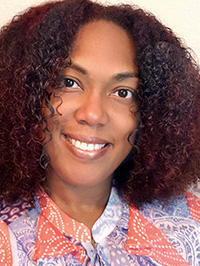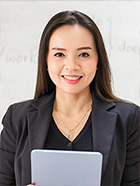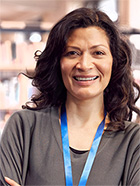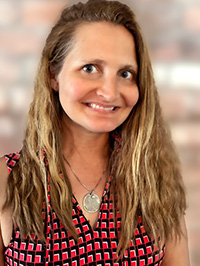How can educators design instruction that engages and challenges all students?
Page 2: Addressing Barriers
 In the same way that students vary as individual learners, they also experience different barriers to their learning processes. A barrier is any aspect related to the design of a learning experience that hinders a student’s ability to access and demonstrate learning. Barriers can differ from student to student, subject to subject, and activity to activity. Some barriers are obvious while others are harder to spot. For instance, a blind student would experience an undeniable barrier if materials were only provided in a visual format. Less apparent barriers might occur when an educator assumes all students possess the background knowledge, prerequisite skills, or vocabulary needed for a lesson. Any barrier, obvious or not, is significant and can impede a student’s learning. Clearly, it is important that educators identify and address potential barriers before students experience them as roadblocks to learning.
In the same way that students vary as individual learners, they also experience different barriers to their learning processes. A barrier is any aspect related to the design of a learning experience that hinders a student’s ability to access and demonstrate learning. Barriers can differ from student to student, subject to subject, and activity to activity. Some barriers are obvious while others are harder to spot. For instance, a blind student would experience an undeniable barrier if materials were only provided in a visual format. Less apparent barriers might occur when an educator assumes all students possess the background knowledge, prerequisite skills, or vocabulary needed for a lesson. Any barrier, obvious or not, is significant and can impede a student’s learning. Clearly, it is important that educators identify and address potential barriers before students experience them as roadblocks to learning.
barrier
Any aspect related to the design of a learning experience that hinders a student’s ability to access and demonstrate learning.
Did You Know?
UDL grew out of concepts associated with universal design in architecture. Universal design removes barriers in buildings, products, and environments to make them accessible to everyone—those with and those without disabilities. For example, curb cuts allow people who use wheelchairs to move freely from sidewalks to streets or parking lots. At the same time, people who use strollers, shopping carts, scooters, and skateboards also make use of curb cuts. Both universal design and UDL highlight how addressing barriers, and thus improving accessibility, benefits everyone.
One of the tenets of UDL is that barriers live in designs, not in students. This is a mindset shift for many educators. When a learner is not progressing, it is common to ask what it is about the student that is holding them back. The educator’s job then becomes one of “fixing” the student. In contrast, when they identify barriers in the design of the learning experience, educators have the power to change them. These barriers can exist in any of the four primary instructional components:
- Goals: the description of what students will understand, know, or be able to do as a result of the learning experience
- Assessments: the method used for measuring student learning
- Methods: the manner in which the content is taught
- Materials: the media, tools, and resources used for teaching content
Rather than trying to determine if the student is ready for instruction, educators who use UDL ask if the instruction is ready for all students. The table below illustrates how educators can shift their mindset away from seeing the barrier in the learner to seeing the barrier in the design and then how they might design instruction to remove that barrier.
|
Viewing Barriers |
Viewing Barriers |
Removing Barriers |
|
The student lacks motivation in math class. |
The goals are disconnected from the student’s interests and experiences. |
The goal is rewritten to highlight an authentic application of the mathematical content to the real world. |
|
The student’s command of the English language is not strong enough to pass a chemistry test. |
The assessment is only offered as a written exam. |
All students are given the option to write, dictate, or demonstrate their learning of the chemistry content. |
|
The student lacks the social skills needed to work with a small group on an assignment. |
The methods do not include instruction or structures to facilitate collaboration. |
Students are taught to use group roles (e.g., leader, recorder, timekeeper, presenter) to structure their collaborative work and complete an assignment. |
|
The student cannot participate in a history project because her reading skills are inadequate to read the textbook. |
The materials are only provided as paper copies. |
All students are provided access to multiple formats of the history text (e.g., print, audiobook, e-book). |
In these interviews, Shauntā Singer and Sarah Wisecarver offer more information on barriers and provide examples of how to eliminate those barriers by providing flexible options.

Shauntā Singer, PhD
Research & Development/
Professional Learning Research Scientist
CAST
(time: 2:28)
Transcript: Shauntā Singer, PhD
Barriers that exist in teaching and learning are those things that get in the way of students meeting various learning goals. And so those roadblocks, barriers, challenges can exist in the form of various things. And what we like to think is that the barriers intuitively or inherently are not in the student, but they can be unintentionally produced in the methods, materials, goals, and assessments that we as instructional designers create. For example, printed material may be how we would traditionally present content. But we have learners who would either prefer and/or have limits to being able to access the information that’s in printed material. And so that material becomes inflexible or access to the material becomes the barrier. And so the idea behind identifying barriers is to think proactively about what specific materials, methods we may use and try to eliminate those barriers so that more students are able to meet those goals. Or, in our example, more students are able to access the information that’s in that printed text. I like to think of printed text for some as being very inflexible, meaning if students have challenges like reading, if they have any visual impairments that prevent them from being able to actually see the print on the paper, perhaps language is not their first language or language of choice, accessing the content in that printed material would be very difficult. And so that’s a very fixed or inflexible material. To make it more flexible and/or eliminating the barriers, we could make it digital so that we could translate or so that it could be spoken out loud to learners who may have those visual impairments. And so the barriers again are things that may be inherent to the particular material that we use. But eliminating the barriers would allow students to meet those goals again in our example, accessing that information in that printed text.
Transcript: Sarah Wisecarver
I really don’t think about barriers in my students. If they are struggling with a lesson, I am constantly thinking about what is the goal of the lesson and what can I do to remove the barriers for them so that they can meet those goals? What options do I need in place? We use the Guidelines as a framework to make that learning accessible for all. So as I am designing my lessons, I’m thinking about how is this lesson going to be accessible to them? For instance, if it’s a reading comprehension lesson, do they have to read it on their own? Could they read it with a partner? Could they read it with me? Is there an audio where they could just listen to it? If the goal is comprehension, could they listen to the audio and still meet that comprehension goal? Absolutely. So thinking about that barrier being curriculum and not the student and providing these options all the time. Students know in my classroom that these are options that are always available to them. Is their table area too loud at the time? Do they need a quieter setting? Do they need to go sit on the floor with a clipboard? Do they need noise-canceling headphones? Do they need to go use a stand-up desk? All of those things are always available, and they advocate for their learning. I’m not telling them what they need as far as helping to make their learning grow and move forward. They are trying to make those decisions. And we have conversations, too. I do work with elementary students. Sometimes they make a decision that might not be the best decision for their learning. Perhaps they thought they needed to work with a partner. And then I notice that they chose a partner that happens to be their best friend, and they get a little chatty and off task. But then I have that conversation, that reflection piece. I’ll go over and speak to them and say, you know, “I’m noticing that maybe the goal of the lesson isn’t being [laughs] done right now. What could we do? What could you do as a learner to meet that goal?” And then have them self-reflect. “Oh, Mrs. Wisecarver, I guess I probably maybe should go work with someone else or work by myself.” It just takes a few seconds, a few minutes, maybe, but having them kind of stop and reflect on it, too.
I always try to think about learner variability, too. So when we’re designing and thinking about the barriers in the curriculum, it’s really saying that at all points and every day, students are variable. I may have a student who’s working really hard, doing a math lesson by themselves at the time. But then the next lesson is a reading lesson, and they’re not engaged in what the content is for that lesson. So even though they worked really well by themselves for that math lesson, maybe they need some support that day on the reading lesson. They don’t understand the vocabulary, or it’s just not something that they have a lot of background knowledge and information about. So maybe they could sit with me for that piece. So there’s that constant ebb and flow in the room of what do they need at that time.
For Your Information
When educators use UDL to address barriers, all students are better able to access the curriculum and exercise their agency as learners. Educators should, therefore, leverage UDL to optimize instruction for all students, with and without disabilities, in inclusive classrooms. Nevertheless, even the most flexible designs do not eliminate the need for special education services and supports for students with disabilities. Educators must continue to ensure that students with individualized education programs (IEPs) receive the accommodations, assistive technology, specially designed instruction, and related services to which they are entitled. These special education supports and services remain essential to providing an appropriate education for students with disabilities.
individualized education program (IEP)
One of IDEA’s six guiding principles; a written plan outlining the education of a student with a disability who is eligible for special education services; this document is developed by an IEP team, reviewed on an annual basis, and includes the individual student’s current level of development, his or her learning goals, and which services and supports the student requires to attend school and receive educational benefit.
accommodation
An adaptation or change to educational environments, materials, or practices designed to allow students with disabilities to access the same instructional opportunities as students without disabilities; it neither changes the learning expectations nor reduces the task requirements.
assistive technology (AT)
Any device—ranging from low-tech (e.g., pencil grip) to high-tech (e.g., voice recognition software)—that can be used to address barriers related to developmental, functional, or learning skills; it also includes services necessary for using a device (e.g., training, repairs). These supports are a type of accommodation for individuals with disabilities.
specially designed instruction
Individualized instruction provided by a special educator to meet the unique academic and functional needs of a student with a disability.
related services
A part of special education that includes services from professionals (e.g., occupational therapist [OT], physical therapist [PT], Speech-Language Pathologist [SLP]) from a wide range of disciplines typically outside of education, all designed to meet the learning needs of individual children with disabilities.
Educators committed to UDL are proactive in predicting and removing barriers when designing the four instructional components. When they view barriers as being within a student, educators often try to make specific adaptations for that individual student. However, educators who understand UDL look for barriers in learning designs and remove those barriers by providing flexible options that benefit all learners.
Returning to the Challenge
Mr. Hughes, Ms. Tong, and Mrs. Rios are now aware that barriers do not exist in their students but in the design of their learning experiences. Keeping this in mind, they take time to consider the barriers that could be preventing some students from accessing and benefiting from their instruction. In the audio clips below, each educator begins to reflect on some of these barriers.

Mr. Hughes
Elementary mathematics lesson instructional focus:
Representing and interpreting data using bar graphs
Reflection (time: 0:20)
Transcript: Mr. Hughes
It seems like graphing should be easy and fun because it’s hands-on, but a lot of my students say it’s boring. The worksheets I use are pretty basic, I guess. I could see how graphing random things like the number of shapes on the page or how many items sold in a pretend grocery store might not be very interesting. That might be a barrier.

Ms. Tong
Middle school language arts unit instructional focus:
Identifying the theme of fictional text
Reflection (time: 0:14)
Transcript: Ms. Tong
All my students read the same book independently, even though I know they’re reading at very different levels. I’m sure that decoding the text and understanding the vocabulary are barriers for some of them.

Mrs. Rios
High school biology lesson instructional focus:
Understanding mitosis
Reflection (time: 0:17)
Transcript: Mrs. Rios
Well, I guess the exam’s a barrier. It’s multiple-choice and timed, and I always have some students who really seemed to get it during class with the models and the diagrams but then they end up failing the exam. I really don’t think I’m giving them a chance to really show what they know.
